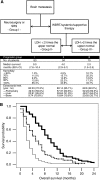Determinants of survival in patients with brain metastases from cutaneous melanoma
- PMID: 20372154
- PMCID: PMC2856002
- DOI: 10.1038/sj.bjc.6605622
Determinants of survival in patients with brain metastases from cutaneous melanoma
Abstract
Background: This retrospective study aimed to identify prognostic factors in patients with brain metastases from cutaneous melanoma.
Methods: In all, 265 patients under regular screening according to valid national surveillance guidelines were included in the study. Kaplan-Meier analyses were performed to estimate and to compare overall survival. Cox modeling was used to identify independent determinants of the overall survival, which were used in explorative classification and regression tree analysis to define meaningful prognostic groups.
Results: In total, 55.5% of our patients presented with two or less brain metastases, 82.6% had concurrent extracranial metastasis and 64% were asymptomatic and diagnosed during surveillance scans. In all, 36.7% were candidates for local treatment (neurosurgery or stereotactic radiosurgery (SRS)). The median overall survival of the entire collective was 5.0 months (95% confidence interval: 4.3-5.7). Favourable independent prognostic factors were: normal pre-treatment level of serum lactate dehydrogenase (P<0.001), administered therapy (neurosurgery or SRS vs other, P=0.002), number of brain metastases (single vs multiple, P=0.032) and presence of bone metastasis (false vs true, P=0.044). Three prognostic groups with significantly different overall survival were identified. Candidates for local treatment (group I) had the longer median survival (9 months). Remaining patients could be further classified in two groups on the basis of serum lactate dehydrogenase.
Conclusion: Applied treatment and serum lactate dehydrogenase levels were independent predictors of survival of patients with brain metastases from cutaneous melanoma. Patients receiving local therapy have overall survival comparable with general stage IV melanoma patients.
Figures

Similar articles
-
Prognostic factors for overall survival after radiosurgery for brain metastases from melanoma.Am J Clin Oncol. 2014 Dec;37(6):580-4. doi: 10.1097/COC.0b013e318280d7be. Am J Clin Oncol. 2014. PMID: 23428955
-
Stereotactic radiosurgery combined with nivolumab or Ipilimumab for patients with melanoma brain metastases: evaluation of brain control and toxicity.J Immunother Cancer. 2019 Apr 11;7(1):102. doi: 10.1186/s40425-019-0588-y. J Immunother Cancer. 2019. PMID: 30975225 Free PMC article.
-
Serum S100B, lactate dehydrogenase and brain metastasis are prognostic factors in patients with distant melanoma metastasis and systemic therapy.PLoS One. 2013 Nov 28;8(11):e81624. doi: 10.1371/journal.pone.0081624. eCollection 2013. PLoS One. 2013. PMID: 24312329 Free PMC article.
-
Identification of prognostic factors in patients with brain metastases: a review of 1292 patients.Int J Radiat Oncol Biol Phys. 1999 Mar 1;43(4):795-803. doi: 10.1016/s0360-3016(98)00442-8. Int J Radiat Oncol Biol Phys. 1999. PMID: 10098435 Review.
-
The treatment of brain metastases from malignant melanoma.Semin Oncol. 2002 Oct;29(5):518-24. doi: 10.1053/sonc.2002.35247. Semin Oncol. 2002. PMID: 12407517 Review.
Cited by
-
Epidemiology and prognosis of brain metastases.Surg Neurol Int. 2013 May 2;4(Suppl 4):S192-202. doi: 10.4103/2152-7806.111296. Print 2013. Surg Neurol Int. 2013. PMID: 23717790 Free PMC article.
-
KPS/LDH index: a simple tool for identifying patients with metastatic melanoma who are unlikely to benefit from palliative whole brain radiotherapy.Support Care Cancer. 2016 Feb;24(2):523-528. doi: 10.1007/s00520-015-2793-7. Epub 2015 Jun 24. Support Care Cancer. 2016. PMID: 26105515
-
Quality of Life and Role of Palliative and Supportive Care for Patients With Brain Metastases and Caregivers: A Review.Front Neurol. 2022 Feb 17;13:806344. doi: 10.3389/fneur.2022.806344. eCollection 2022. Front Neurol. 2022. PMID: 35250815 Free PMC article. Review.
-
Aquaporin-1 Protein Expression of the Primary Tumor May Predict Cerebral Progression of Cutaneous Melanoma.Pathol Oncol Res. 2020 Jan;26(1):405-410. doi: 10.1007/s12253-018-0513-6. Epub 2018 Oct 30. Pathol Oncol Res. 2020. PMID: 30378011
-
Outcomes after stereotactic radiosurgery of brain metastases in patients with malignant melanoma and validation of the melanoma molGPA.Clin Transl Oncol. 2021 Oct;23(10):2020-2029. doi: 10.1007/s12094-021-02607-8. Epub 2021 May 15. Clin Transl Oncol. 2021. PMID: 33993415 Free PMC article.
References
-
- Agarwala SS, Keilholz U, Gilles E, Bedikian AY, Wu J, Kay R, Stein CA, Itri LM, Suciu S, Eggermont AM (2009) LDH correlation with survival in advanced melanoma from two large, randomised trials (Oblimersen GM301 and EORTC 18951). Eur J Cancer 45: 1807–1814 - PubMed
-
- Aoyama H, Shirato H, Tago M, Nakagawa K, Toyoda T, Hatano K, Kenjyo M, Oya N, Hirota S, Shioura H, Kunieda E, Inomata T, Hayakawa K, Katoh N, Kobashi G (2006) Stereotactic radiosurgery plus whole-brain radiation therapy vs stereotactic radiosurgery alone for treatment of brain metastases: a randomized controlled trial. JAMA 295: 2483–2491 - PubMed
-
- Balch CM, Buzaid AC, Soong SJ, Atkins MB, Cascinelli N, Coit DG, Fleming ID, Gershenwald JE, Houghton Jr A, Kirkwood JM, McMasters KM, Mihm MF, Morton DL, Reintgen DS, Ross MI, Sober A, Thompson JA, Thompson JF (2001) Final version of the American Joint Committee on Cancer staging system for cutaneous melanoma. J Clin Oncol 19: 3635–3648 - PubMed
-
- Brand CU, Ellwanger U, Stroebel W, Meier F, Schlagenhauff B, Rassner G, Garbe C (1997) Prolonged survival of 2 years or longer for patients with disseminated melanoma. An analysis of related prognostic factors. Cancer 79: 2345–2353 - PubMed
-
- Buchsbaum JC, Suh JH, Lee SY, Chidel MA, Greskovich JF, Barnett GH (2002) Survival by radiation therapy oncology group recursive partitioning analysis class and treatment modality in patients with brain metastases from malignant melanoma: a retrospective study. Cancer 94: 2265–2272 - PubMed
MeSH terms
Substances
LinkOut - more resources
Full Text Sources
Medical

